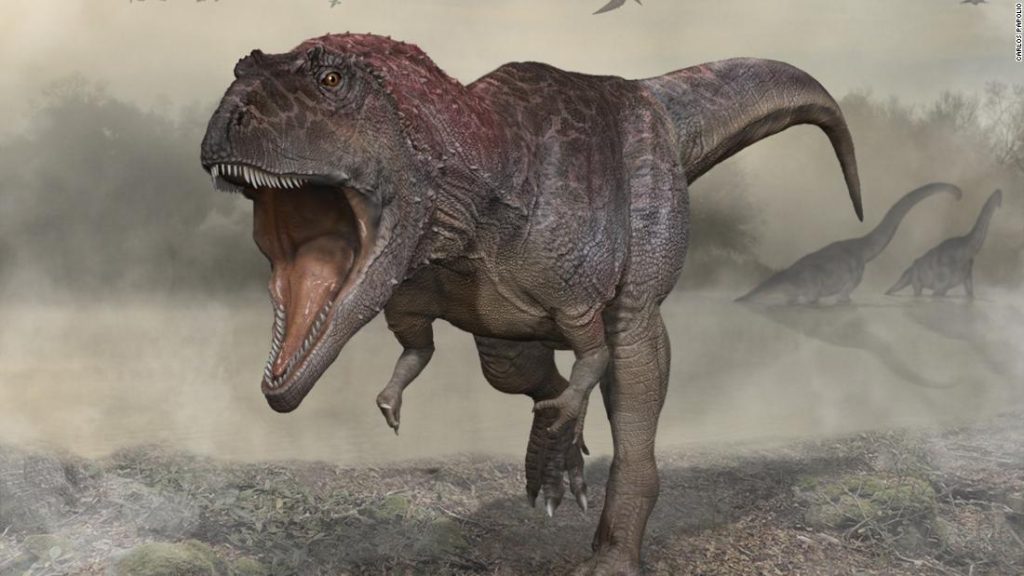At the time the area was hot and humid with plenty of waterways and vegetation including large trees, Juan Canal, project leader at the Ernesto Bachmann Museum of Paleontology in Neuquen, Argentina, told CNN.
This carnivorous animal is from the Carcharodontosauridae group of dinosaurs, which lived in the Cretaceous period, 145 to 66 million years ago, according to the study.
A group of Carcharodontosauridae fossils have been found in the past 30 years, but little is known about their skull, forearms, or feet.
That changed with the discovery of M. gigas, thanks to the remarkably complete fossil.
“For the first time we know, in so much detail, certain parts of the anatomy of these giant carnivorous dinosaurs,” Kanal said.
The researchers found a nearly complete forelimb, allowing them to conclude that M. gigas had the small arms of such a large dinosaur, a physical feature shared with T. rex that has long puzzled paleontologists.
They also found a nearly complete skull and foot, which allowed them to shed light on how this group of dinosaurs evolved, Kanal said, explaining that there was a trend towards larger body sizes, larger skulls and smaller arms in proportion to the body.
‘There was some kind of arms race’
The fossil was found in the Huincul Formation, where the study said the remains of one of the largest known land animals of all time, Argentinosaurus huinculensis, were found from the same period as the fossil of M. gigas.
The area is also known to have been home to other carnivorous, albeit smaller than M. gigas dinosaurs, as well as other types of long-necked herbivores.
It’s generally very difficult to determine what dinosaurs ate, Kanal said, but loose teeth have been found at excavation sites where herbivorous dinosaur fossils were discovered along with carnivorous dinosaurs.
This, he added, means that we can say that M. gigas would have preyed, at least in part, on these long-necked herbivores such as Argentinosaurus huinculensis.
“It is no coincidence that giant herbivorous dinosaurs and giant carnivorous dinosaurs lived in the same environments,” Kanal said, who explained that as herbivores evolved larger bodies as a form of defense, carnivores did too in order to be able to prey on them.
“There was some kind of arms race,” he said.
“No direct relationship” to T. rex
But the team says that M. gigas evolved separately into T. rex and became extinct roughly 20 million years before T. rex ever walked on Earth.
Kanal said that although both dinosaurs had large heads and small arms, their skeletons were very different.
“There is no direct relationship,” Kanal said.
Kanal said that the ancestors of M. gigas had longer arms and smaller heads and their arms were important in hunting, but this has changed over time.
Previous research found that dinosaur species such as M. gigas and T. rex developed smaller arms when their heads got larger.
Kanal said this indicates that the weapons were not used for hunting, and instead used their heads to kill their prey.
“What I think is that in more advanced forms … activities related to predation, such as capturing or carrying prey, could have been done immediately with the head,” he said.
However, the fossil shows that although the arms were short, they were muscular, and the chest muscles were well developed, Kanall said.
“This does not correspond to a limb that has no function,” he said, adding that it could have been used to help get up off the ground, or as a support for the female when mating. Researchers don’t know if this fossil belonged to a male or female dinosaur.
The team also found that M. gigas had decorations such as crests, grooves, protrusions and tiny carnations on its skull, which were likely used to attract potential mates.
Kanal said there is still more work to be done on M. gigas, and a colleague at the museum is writing a treatise on his feet and arms.
In addition, there are plenty of fossils that still need to be excavated in the area, as well as dinosaur footprints for analysis, he said.
“We have a lot of work to do,” Kanal added.

“Typical beer advocate. Future teen idol. Unapologetic tv practitioner. Music trailblazer.”






More Stories
Pluto's core was likely created by an ancient collision
UF scientists hope to stop deadly bronzing disease in Florida palm trees
fast! Someone get this doctor book.